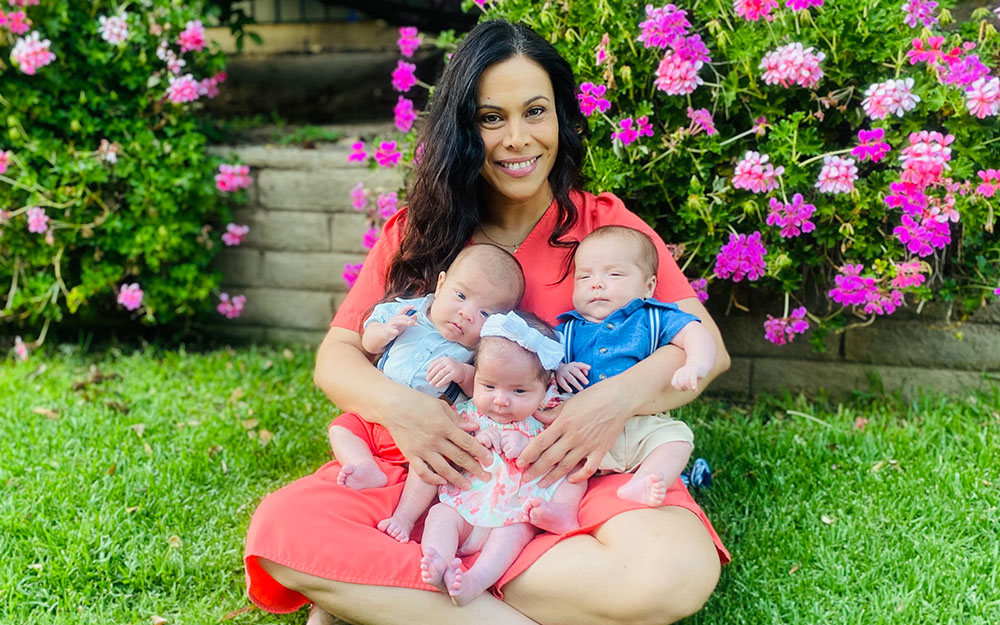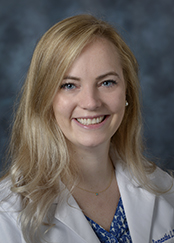Cedars-Sinai Blog
Three's a Charm: Woman Has Triplets After "Roller Coaster" Journey
Apr 21, 2021 Jasmine Aimaq

A moment of joy

Samantha Thomson, MD
Twenty-four weeks. Rommy Coutelin knew that was the crucial milestone. If her pregnancy made it to 24 weeks, her babies had a real chance of being OK. All three of them. The journey had not been easy.
She already had two boys, ages 16 and 21, from a previous marriage. Now she and her new husband, Casey, wanted children together. In her 40s, Rommy knew there would be challenges. She got pregnant but suffered a miscarriage. The couple decided to turn to in vitro fertilization (IVF), and thus began an unpredictable journey.
"It was a roller coaster of emotions," says Rommy.
Rommy decided to transfer three embryos. There was an 80% chance that one would take, and 40% odds of twins—far higher than for non-IVF pregnancies. Triplets were very unlikely. Within four days, a pregnancy test was positive.
"Casey and I were happy, but cautious," says Rommy. "It was early, and lots could go wrong." She messaged her OB-GYN, Dr. Samantha Thomson, to share the happy news, but told almost nobody else.
"It is not easy having three babies, but the joy is overwhelming."
A moment of truth
By now, the COVID-19 pandemic was well underway, and Rommy had to go to one of the most important appointments of her life alone.
"I went to see Dr. Thomson at six weeks for an ultrasound to find out if the pregnancy was viable," she recalls. "Casey wasn't able to come with me, so having Dr. Thomson there for me was incredibly meaningful. She made me feel safe and truly cared about." Dr. Thomson describes her patient as "a rock star who came in with a smile on her face, ready to face anything."
With Casey on FaceTime, Dr. Thomson began the ultrasound. She detected a heartbeat. "We were all relieved," Rommy says. Then they found a second heartbeat. Rommy wasn't too surprised because she knew twins weren't uncommon in IVF, and twins ran in the family. Then came a third heartbeat. "I almost fainted from shock,” she says.
The phone trembled in her hand as she and Casey took in the news. Originally from Chile, Rommy had a background as a midwife and understood what the news meant. The chance of triplets was low to begin with but being able to carry all of them to term was highly unlikely. "I was 50% happy and 50% terrified," she says. Meanwhile, Casey was ecstatic.
"Women who are undergoing IVF often have risk factors, such as being over 35 years old when they deliver. That means an increased risk of miscarriage, stillbirth, chromosomal issues, high blood pressure of pregnancy and gestational diabetes, to name a few."
A moment of fear
They still told almost nobody. There was a real risk the pregnancy would not make it past the first trimester. Dr. Thomson ordered more tests and ultrasounds than typical to ensure everything was OK. Eight weeks in, it almost wasn't.
Rommy woke up at 3 a.m. with massive bleeding. Casey rushed her to the hospital. She'd suffered a subchorionic hematoma (an accumulation of blood between the uterine lining and the chorion—the membrane surrounding the embryo). All three babies were fine. Relief was mixed with the reality that nobody was out of the woods yet.
"Women who are undergoing IVF often have risk factors, such as being over 35 years old when they deliver," says Dr. Thomson. "That means an increased risk of miscarriage, stillbirth, chromosomal issues, high blood pressure of pregnancy and gestational diabetes, to name a few."
Pregnancies with multiple babies heighten those risks, and come with a high chance of preterm delivery, usually before 32 weeks (full-term is 37 weeks). "Triplets almost never go past that," Dr. Thomson explains. "Very early delivery can mean lots of complications for babies, such as risk of death, long Neonatal Intensive Care Unit (NICU) stays, and problems with breathing and cerebral palsy later in life. The more time babies gestate, the less time they need in the NICU."
"I was 50% happy and 50% terrified."
The miracle
Rommy also knew she might lose at least one of the babies before that. "If everything was alright at 24 weeks, I would likely be delivering all three of them," says Rommy, "so that was a crucial date."
At 24 weeks, everything looked good. "It started to feel like a miracle," she says.
The final weeks were physically uncomfortable and she didn't eat or sleep much during that time. Her sons were worried and did all they could to help care for her, as did Casey. "My mother-in-law also came to stay and I don't know what I would have done without her," Rommy recalls.
On Feb. 16, she gave birth to full-term triplets via cesarean section with no complications. Infants Gabriel, Daniel and Victoria spent very little time in the NICU and are all happy and healthy.
"It is not easy having three babies, but the joy is overwhelming," says Rommy. "It's a bright light for my family during the pandemic."
Rommy and Casey are both employees at Cedars-Sinai. Along with the first-rate medical care that Cedars-Sinai provides all its patients, and her maternity leave, Rommy says she has been moved by the love and support she's received at the medical center.
She describes her supervisors as "outrageously supportive." "I have always been proud and grateful to work at Cedars-Sinai," she says. "I am even more proud now that I've been a patient and experienced first-hand the care we provide."


